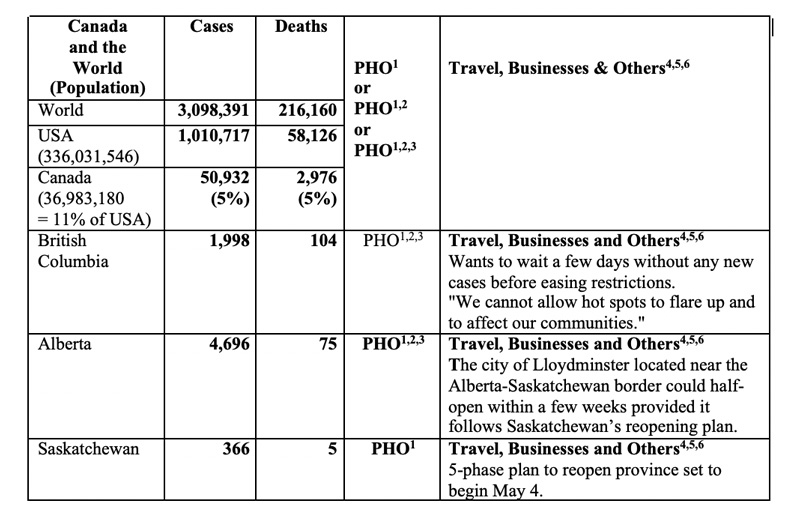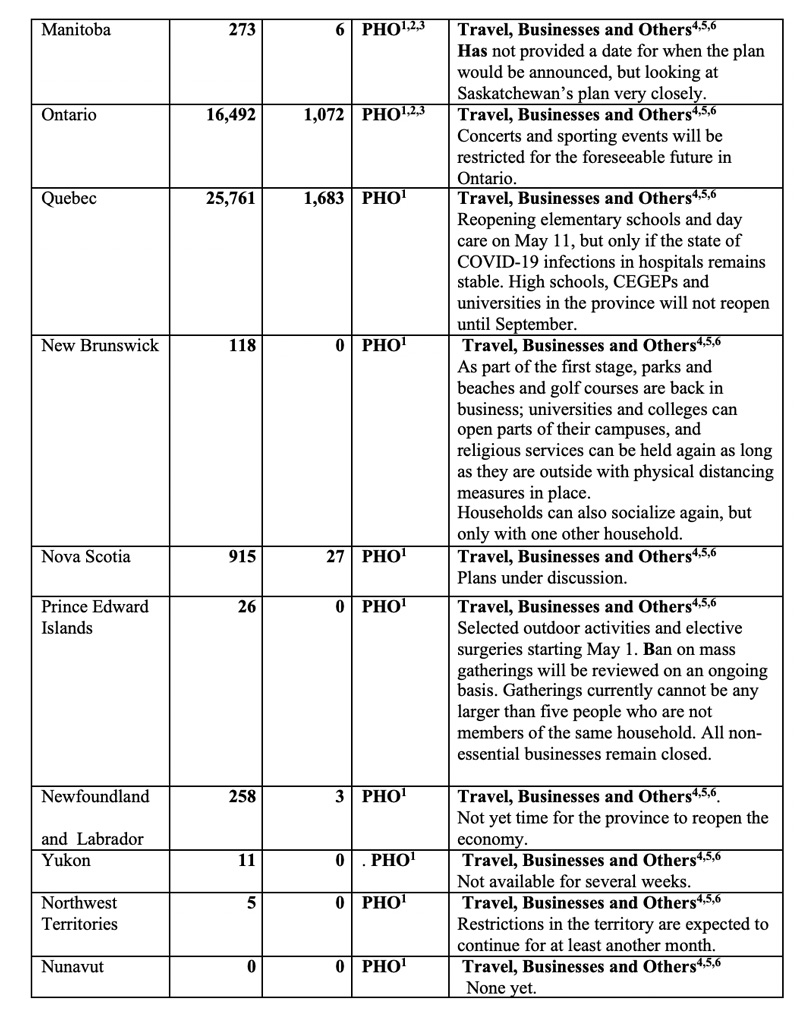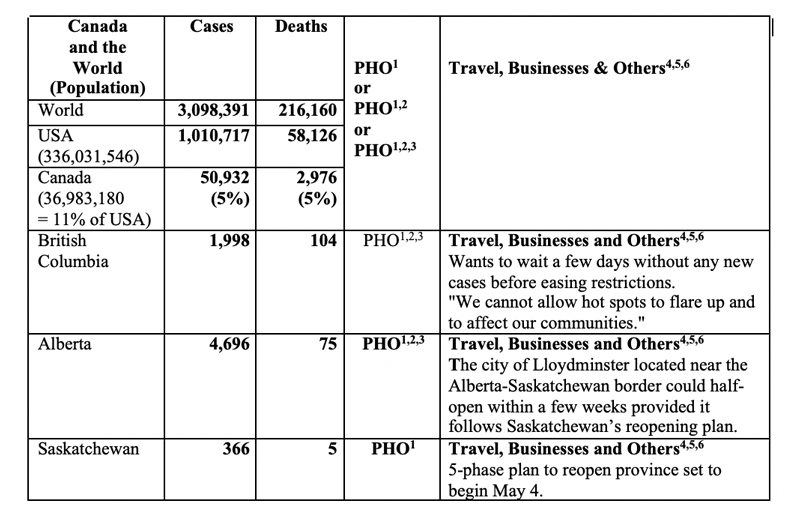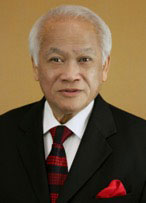(This is Part 7 of Dr. Pagtakhan’s column, Medisina at Politika , on Covid-19.)
Loss of Lives and Livelihoods Needs Creative Leadership and Hope
April 28, 2020 - Three nights ago the mountainous village of Zermatt in Switzerland – some 7,000 flight-kilometers away - projected and illuminated Canada's red and white maple leaf flag on the side of the Matterhorn, one of the highest peaks in Europe (see photo image above). It was the town’s show of its global solidarity and hope with the people of Canada and the world during these trying times of the COVID-19 pandemic.
A very contagious respiratory illness, this new disease in barely five short months has sickened over 3-million citizens, claimed more than 200-thousand lives, and weakened the economies of nation-states worldwide (see Table below). As of today, our neighbour to the south – the USA – has just surpassed, sadly, the 1-million counts of Americans taken ill – a third of the world’s total. Even more difficult to understand are the more than 50-thousand American patients including healthcare providers who perished. They constitute a quarter of the world’s total lives lost. While Canada’s shares of the sick and the deceased are gratefully less than those of our southern neighbours on a per capita basis, our national suffering is no less painful to bear. How fitting and beautiful then that the small Swiss village would conceive and display a “brilliant show of solidarity” and hope for all of humanity.
First Ministers’ Joint Statement on Re-starting the Canadian Economy
What a nice continuity three days later from three nights ago! Today, Prime Minister Trudeau released the First Ministers’ joint statement on re-starting the Canadian economy. Their joint statement is a leadership echo of collaboration and coordination and tinctured at all times with humanitarianism, empathy and cautious optimism (see Guiding Principles and Criteria below).
Indeed, only a cooperative and coordinated global response on all fronts has the best chance at taming the contagious COVID virus. And it begins at the national level. Canada’s 10 provincial and 3 territorial governments have shown what it meant when 14 government leaders work creatively and collectively for the safety and well-being of their citizens – young and old, women and men, healthy and disabled, free and in prison, rich and poor, well fed and hungry.
In the absence of a curative antiviral drug or preventive vaccine, SARSCoV-2 - the tiny infectious pathogen of this new respiratory malady – will continue to travel around the local and global communities and upend lives and livelihoods. All we have at our disposal to break the human chain of transmission are personal and community measures, namely: stay-at-home or shelter-in-place, physical distancing and 14-day self-isolation following travel from abroad; prohibition against non-essential travels and big public gatherings; mandatory use of face masks; advisory against neighborly and extended family visits, dining out in restaurants, attendance at places of religious worship, and visits to recreational places, the beaches and summer cottages; closure of educational institutions; and limits to being employed in more than one residential home for the elderly. No doubt these public health orders (PHO), singly or in combination, have restricted individual liberties and interrupted normal life and living.
However restrictive and interruptive these PHOs have been to all concerned, Canada has shown her citizenry and the world that through collective discipline and sacrifice as a nation the infectious beast can be tamed. The most recent COVID-19 modeling released today confirms that public health measures have been effective in slowing the spread of the disease. Dr. Theresa Tam, Canada's chief public health officer, observed the number of new cases of COVID-19 was doubling every three days previously, and is now doubling every 16 days.
Prime Minister Justin Trudeau injected a dose of cautious optimism. "The measures we have taken so far are working…in many parts of the country... But we are not out of the woods yet…and if we lift measures too quickly, we could lose the progress we've made."
Guiding Principles to Gradual and Phased Approach to Restarting the Economy
“A shared key objective,” says the First Ministers statement of today “is to minimize the risk of another wave of COVID-19 that forces governments to re-impose severe restrictions, further damaging the social and economic fabric of communities.” They acknowledge the value of “restarting the economy through a gradual and phased approach.” The guiding principles include the following:
- Science and evidence-based decision-making– Decisions to ease and/or reinstate measures should be based on current public health situations, as advised by public health officials.
- Coordination and collaboration– First Ministers firmly believe that strong collaboration to date has served Canadians well, and that continued collaboration is key to ongoing success… Since provinces and territories and the Government of Canada may need to move forward at different times and in potentially different ways, it will be important to maintain the coordination and collaboration that has taken place throughout the pandemic.
- Accountability and transparency– Each government will continue to be accountable to its residents, and will monitor the impacts of measures to restart the economy and provide updates on progress. Data sharing is critical to understanding the situation across Canada and is essential to informing efforts to re-open segments of the economy.
- Flexibility and proportionality –Public health measures should be relaxed based on the level of threat, and in a controlled and phased manner, based on information that may change over time. This includes information on risks around the disease and health of Canadians as well as social and economic benefits to them… It is recognized that there will be differences within jurisdictions on approaches taken and that measures may need to be re-imposed if the understanding of the information changes.
Criteria and Measures Needed to Restart the Economy
Furthermore, the First Ministers recognize that there are varied factors – public health officials’ analysis of public health data, population and geographic considerations, and economic movements, to mention some – that would play a role on decisions regarding where, when, and how measures are lifted. Hence, the First Ministers “agree that decisions should be informed by the following criteria and measures (abbreviated)
- COVID-19 transmission is controlled– The incidence of new cases should be maintained at a level that health care systems can manage, with substantial clinical care capacity in reserve.
- Sufficient public health capacity is in place to test, trace, and isolate all cases– Testing and contact tracing are in place so that suspected cases are detected quickly and all confirmed cases are effectively isolated, while all close contacts are traced, quarantined, and monitored.
- Expanded health care capacity exists for all patients, COVID-19 and non-COVID-19– Health care systems should support all needs, including dealing with any future outbreaks, recognizing that this will be achieved through having surge capacity in place and other means to enable the system support for COVID and non-COVID patients. Provinces and territories are best suited to determine how comprehensive health care services are supported, including primary care, diagnostic services, and acute care services including elective surgeries and non-COVID emergencies. … Procurement of supplies will ensure that there is adequate supply on hand in case of a resurgence of the virus and to support enhanced testing.
- Supports are in place for vulnerable groups/communities and key populations– Measures are in place to prevent the uncontrolled spread of the virus in vulnerable populations, which can directly lead to increased community spread. Sustained measures are in place to protect seniors, residents of group living facilities, workers in close quarters, inmates, homeless people, and Indigenous people and those living in remote locations, along with health care workers and other essential workers.
- Workplace preventative measures– Support and monitoring of workplace protocols are in place to prevent the introduction and spread of COVID-19. Strong collaboration and oversight processes are in place to ensure protocols are being met.
- Avoiding risk of importation– Restrictions on non-essential domestic travel should be eased and managed in a coordinated manner. Re-opening of international borders and access for non-Canadian residents may only happen in later stages, taking into account the spread of the virus outside Canada, and measures to avoid the spread of the virus for everyone entering the country.
- Engage and support– The success of managing COVID-19 will depend on the ability of communities to use and keep the necessary measures, particularly for public services. Governments will support communities in managing local disease activity, including in child care, schools, and public transportation. Governments will also work with industry and economic sectors to support optimal health, reduced viral activity, and protection of the economy as it restarts.”
Illustrative Statistics as of April 28, 2020 at 1700 Hour:

















